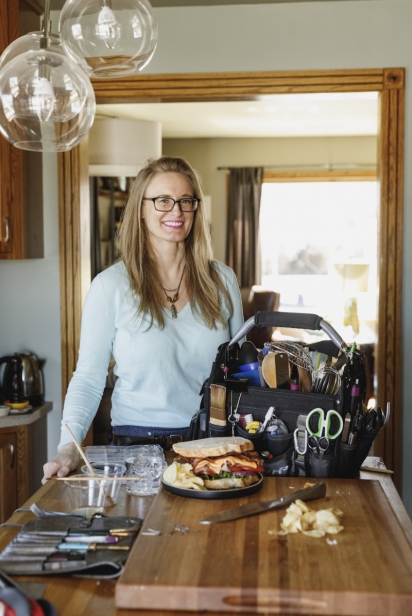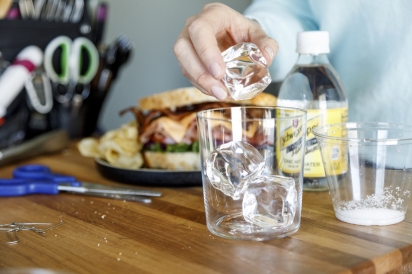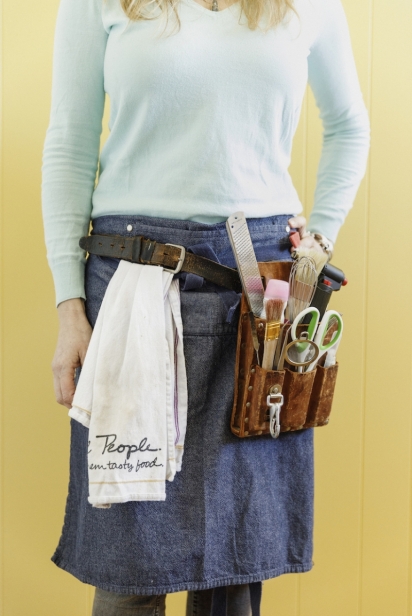Too Beautiful to Eat
There are two types of people in this world, those who take pictures of their food and those who don’t. Thank you, Instagram, for the “Phone Eats First,” phenomenon: the growing obsession with “Insta-worthy,” food photos. For Laurel Ziemienski (professionally known as “Laurel Z”) creating beautiful images of food isn’t just social media fun, it’s her passion, her profession and to paraphrase Donna Summer, Ziemienski works hard for the money (shot).
Instagram has impacted the food styling business and Ziemienski embraces it. “It’s fascinating to see how quickly the industry is changing because the mass population is determining the trend. Some of my clients want food to look the way it does on Instagram. I did a national commercial for Kentucky Fried Chicken two years ago and they shot the entire commercial on an iPhone,” Ziemienski says. “People are used to seeing that and having fewer expectations for perfection is a little bit easier on the stylist,” she adds.
As a former fashion stylist, Ziemienski had an eye for aesthetics and a network of potential clients when the idea of working with food hit her radar. “I went to school for fashion merchandising at Mount Mary, then worked at Kohl’s for three years as a wardrobe stylist.” But Ziemienski had no idea that a random dinner would lead to a new career. “I had my agent over for dinner and she said ‘You need to be a food stylist, there’s more money and less competition in the market.’ That was 10 to 15 years ago,” Ziemienski recalls.
The freelance learning curve wasn’t terribly steep, but Ziemienski realized she needed to work on her cooking skills. “I needed to learn how to cook for photography purposes. I’ve been interested in cooking and my mom has always been a good cook. My food knowledge is self-taught. I understood what good food was and how to put food together. I found a photographer in Chicago who was looking to put a food portfolio together and he started booking me as a lead stylist,” Ziemienski explains.
“There’s a big difference in the liberties you can take between cooking food to eat and cooking for photography purposes,” Ziemienski adds. Determination, flexibility and patience are important traits for this dedicated professional; when a sandwich chain booked her for a shoot, Ziemienski handled last minute challenges like a trooper. “We had to build sandwich boxes and two, two-foot long subs… they needed everything to look perfect and they needed the exact weight in slices of onions and lettuce, I built the first sub and had agency and client approval. I built the second sandwich and just before we were about to shoot, someone from the agency said, ‘Can you slice these into one-inch pieces?’ I would normally use staple pins, toothpicks, maybe some glue or cotton balls or makeup sponges to fill in space,” Ziemienski explains. But because actors would be biting into the sandwich, it all had to be edible. Ziemienski successfully accommodated the client’s demands. “I had to very delicately slice the sub an inch at a time and reassemble each slice. I did the best I could and we got it on camera and they were happy,” she recalls.
Stylists employ a plethora of tricks to create camera-ready food and Ziemienski shared some of her go-to tricks for not-for-consumption food. An edible combination of ingredients makes an aesthetically appealing but less than palate pleasing ice cream substitute: “If it’s not the focus of the shot, I use a mixture of powdered sugar, corn syrup and Crisco,” she admits. When it comes to baked goods that only have to look delicious, Ziemienski thinks outside of the kitchen. “We were doing lavender lemon bars and we wanted to show a dusting of pretty purple all over them… I said, ‘Why don’t I get powdered blush?’”
A food stylist’s best friend is their bag of gear, and Ziemienski never leaves home without Big Bertha. “Big Bertha is a tool kit that holds my essentials: I’ve got Q-tips, tweezers, scissors, eight different ways of making fire, I’ve got the butane lighter, a large blowtorch and a large attachment for my blow torch to spread the flame apart. A lot of times I use those on beef if I need it to look charred a certain way. I have clear corn syrup, vegetable oil is always in there, a ruler, toothpicks, skewers and different types of pins… twine and fishing line.”
While every day and every meal is a new adventure, Ziemienski follows a consistent preparation process, “A typical job is when I get the food requirements several days in advance, I prefer to do all my own shopping and I’ll prep the food at home or in the studio. And then I start the morning of shoot day prepping the first dish. I have an assistant and we plate everything. Then I do final touches and pull out the tweezers for fine tuning, like if this piece of lettuce is out of place or there’s a crumb on the surface. At the last minute, I spritz any fruit or vegetables with water to give it a fresh look.”
Beverages present their own set of challenges, “If I’m shooting a cocktail, I use my fake ice or spritz the glass with a mix of corn syrup and water to mimic condensation, the water dilutes the corn syrup and the corn syrup keeps the water from evaporating. If it’s less editorial and more commercial, there could be five people from the agency and the client analyzing every drop I put on there,” Ziemienski explains.
Glycerin is another trick of the trade, Ziemienski says, “You can use glycerin on block cheese, like yellow cheddar, to give it a fresher look if it starts getting a little dry under the camera lights. Another trick for melted cheddar cheese, I squeeze disinfectant from a wipe into a bowl and paint it onto the cheese.”
Thinking of trying this on your next platter of nachos? DON’T do it for the Insta, some tricks are best left to the professionals.








